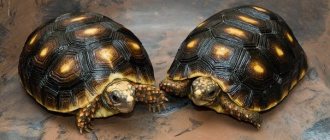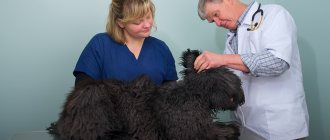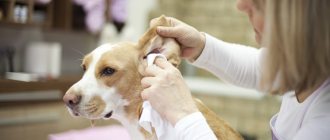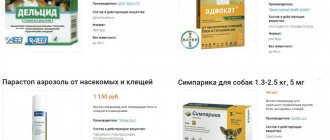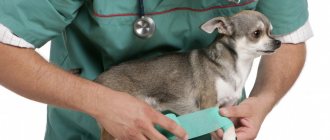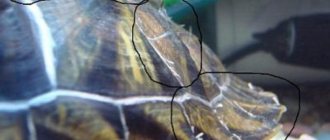Since childhood, we have associated the image of a turtle with two of the cutest representatives of this type of reptile - Tortila with her golden key and the Turtle, who in the famous cartoon sang a duet with the Lion Cub a song about “I’m lying in the sun...”
Maybe that's why these exotic animals are readily kept as pets. Children especially love them. Turtles have an extremely calm, accommodating disposition, and their appearance is quite attractive. They do not require special care.
However, like any living creature, problems may arise that will cause panic among the owners of the “tortillas”. In particular, they can be so connected with the shell that they can tell a lot about the state of health of the reptile.
And if not molting, then what?
However, the symptom of turtle shell peeling may indicate other, more serious reasons not related to molting:
- vitamin A imbalance,
- fungal diseases,
- rickets.
The first ailment is characterized by the formation of ulcers, very severe peeling or flaking of the skin. The scutes peel off from the shell (this does not apply to decorated turtles), and even quite large pieces come off.
An indicator of a fungal disease or dermatitis can be prolonged molting. In an amphibian, the scutes are not completely removed, but under them or on the skin of the animal, areas and sores with a pinkish tint form. White spots appear on the shell of a sick animal. The skin in the folds exfoliates and flakes, causing swelling and pimples. The turtle is suffering from severe itching.
Interesting Facts
As we have already found out, a turtle without a shell existed only at the dawn of its evolution. What other interesting facts can you tell about them?
- The turtle's house consists of fifty different parts and only seems to us to be a single whole.
- The cervical spine of this amphibian consists of eight parts. To retract its head, the turtle is forced to fold its neck three times, in the shape of the English letter S.
- Some Tortilla species are able to tightly close the openings for the head and tail with movable shields on the shell.
- Much earlier than the famous Belka and Strelka, it was turtles who went to the moon. This happened in 1968 in the Soviet Union. The amphibians remained not only alive, but also quite healthy, only losing a little weight.
- Many turtles are fierce predators. Despite the fact that they have no teeth at all, they eat their prey using a strong, leathery beak.
- They do not have vocal cords, but they can still make sounds - hooting, grunting, hissing and something like cackling. They do this in a special way, shaking their heads and thus forcing the air to compress in their lungs.
- Some species of turtles can breathe through their butts. Their anus (cloaca) is closed with a special membrane, which, when kept under water for a long time, is capable of allowing oxygen into the blood.
We hope you found the article interesting.
Injuries and burns
Often such reptiles can be injured, and the most common injuries include:
- Burns.
- Fractures of limbs or shell.
- Skin wounds.
- Bruises.
Minor injuries that are no larger than medium in size should be treated with Chlorhexidine or Furacilin. You can also use Dioxidin to wash wounds. After the damage has been treated, it is necessary to apply the drug, which can dry the wound, but the use of iodine and other products with alcohol is prohibited.
If the wounds are open and bleeding, then the reptile should be placed for a couple of days in a container with a special film, which is used in medicine or with napkins. This will prevent the animal from becoming infected in addition to the injury received.
After a couple of days, the pet can again be left in the aquarium and taken out only to treat injuries for a couple of hours. When the healing process takes place and a characteristic crust appears, you can use ointments that quickly heal wounds, for example, Rescuer.
Bruises in reptiles go away on their own, but treatment of burns is carried out by a doctor or independently, pre-treat the damage and then apply products, for example, Panthenol or Levovinisol. Other injuries should only be treated by a doctor.
Prevention measures
Any disease is easier to prevent than to treat. Turtle shell problems are no exception. To avoid them, provide your reptile with adequate nutrition. The menu should consist of food of animal and plant origin.
Buy a UV lamp and give your turtle irradiation sessions to produce vitamin D in its body, which facilitates the absorption of calcium. In summer, take your turtle outside for walks. At the same time, make sure that the animal does not come into direct sunlight.
Pay attention to the water you fill the aquarium with. Its excessive rigidity can negatively affect the condition of the shell. This water must be filtered.
In addition, tap water contains chlorine, which causes certain diseases. Let it sit for a day before pouring it into the aquarium so that the harmful impurity has time to evaporate.
What do red-eared turtles suffer from?
There are a variety of diseases that affect red-eared turtles. Ailments are divided into main groups:
- Diseases of the bones and shell caused by a lack of vitamins in the animal’s body, especially calcium.
- Respiratory diseases. The most dangerous ailment is pneumonia in red-eared turtles.
- Intestinal diseases caused by pathogenic bacteria or occurring when helminths parasitize the body.
- Diseases of the hearing organs, in particular, otitis media in the red-eared turtle.
- Skin diseases of fungal and bacterial nature.
The listed ailments can lead to serious disorders in the turtle’s body if timely treatment is not carried out. In order not to start the disease, it is important to provide timely help to the animal, and for this you need to know the main symptoms and signs of each disease.
Predatory pets
The little red-eared turtle loves to eat raw meat because it belongs to the category of predators.
It is worth remembering that the cute, now domestic, red-eared turtles were once part of the wild, in which they had to fight for survival. They defended themselves from lovers of turtle meat (both on land and in water), and competed for the best place in their flock. Therefore, careless play with this animal (especially at the time of eating, mating or pregnancy) can turn into a big nuisance. The fact is that this predator can perceive such games as an attack on its peaceful existence and react very hostilely. This animal demonstrates its displeasure by strongly biting its ill-wisher.
Although these reptiles do not have teeth, the bite force of a turtle can be quite impressive. The animal’s powerful jaws bite into the “enemy” with an “iron grip” and often leave a bloody wound that takes a long and painful time to heal.
The red-eared slider is named for the colored stripes behind its eyes, but these animals do not have ears.
It's easier to warn...
Spots on the shell.
And a few more “preventive” tips.
Proper feeding is largely the key to turtle health. This reptile should have both animal and plant food on the “dining table”. Exclusively meat products on the menu can provoke the occurrence of vitamin A deficiency and rickets. The turtle's diet should be varied: vegetables and fish, fruits and berries.
Spots on a turtle's shell can appear due to excessively hard water, so before adding it to the aquarium, the liquid must be carefully filtered.
In addition, tap water is often disinfected with chlorine, which can also cause a number of diseases. The water in the aquarium should be changed only after settling for a day. During this time, the gas will evaporate.
Silent pet turtles are unable to tell their owners about their poor health. It is possible to determine that they are unwell only by their appearance and changes in behavior. One of the important clues about a pet’s well-being is the appearance and condition of its shell. Any responsible owner of a cute reptile should be aware of what "turtle armor" can tell you.
Feeding
The issue of preparing your pet’s diet must be approached very responsibly. Very often, incorrectly selected food provokes red-eared turtle disease.
In an aquaterrarium, the diet of red-eared turtles should include small crustaceans (gammarus or shrimp). Your pet will not refuse small aquarium or river snails. You can finely chop ocean fish, meat, and liver.
Owners are often interested in the question of what diseases red-eared turtles carry. It should be noted that most pathologies are associated with the condition of the shell - softening, delamination, etc. This is often observed with a lack of calcium. To avoid such problems, it is necessary to include in the animal’s diet foods rich in this element - fish heads, bone meal, eggshells, chalk.
We must not forget about useful supplements in the form of plant foods. Turtles enjoy eating leaves of cabbage, dandelion, spinach, plantain, and lettuce. Among the algae, they will like elodea, duckweed, seaweed, edogonium, anacharis, and water beetle. Young turtles should be fed twice a day. Then they are transferred to a single meal. Reptiles over two years of age are fed no more than three times a week.
Causes
Most often, swollen eyes are caused by the following factors:
- monotonous food;
- keeping an animal in dirty water;
- hypothermia;
- too bright lighting;
- no ultraviolet lamp.
Avitaminosis
If the problem is caused by a lack of vitamin A, then, in addition to swelling of the eyes, peeling of the skin is clearly visible. Also, a cheesy coating may form on the tongue, emitting an unpleasant odor, and trophic ulcers may appear on the skin.
Conjunctivitis
The causative agents of this infectious inflammatory disease are streptococci and staphylococci. Allergies or poor living conditions can trigger the disease.
The inflammation usually affects one eye, but can spread to the other. In a sick animal, the conjunctiva turns red, the eyelids swell, a white purulent coating appears, and the eyes water.
If left untreated, the temperature rises, coordination of movements is impaired, and appetite disappears.
Color change
A small air bubble appears under the horny shield in turtles when they begin to molt. This is normal. But if the number of bubbles increases, and the armor begins to change shade, then this does not indicate natural causes, but the development of pathology or infection. Often this phenomenon is bacterial or fungal in nature. In the absence of timely qualified assistance, the shell will begin to collapse.
Urgent assistance from a veterinary dermatologist is required if an accumulation of dark liquid resembling blood appears in the cavity under the armor. This may indicate kidney failure. Without treatment, the disease leads to the death of the animal.
Bacterial damage to the shell in freshwater animals manifests itself in the form of the formation of pink roughness on the surface of the armor. In the future, this will lead to the death and destruction of bone tissue.
Pneumonia
This dangerous disease can occur either as a result of hypothermia or due to air stagnation in the terrarium. Signs of pneumonia are:
- mucous bubbling nasal discharge (runny nose);
- swelling of the eyelids;
- rapid breathing through the mouth;
- in the water the animal floats up sideways (with the affected part of the body facing up);
- lethargy and lack of appetite.
If the listed signs are noticed, it is immediately recommended to call a veterinarian at home. The fact is that pneumonia in red-eared turtles is most effectively treated with antibiotics (intramuscular injections), and the dose of the medicine is prescribed by the doctor depending on the size, weight of the patient and the stage of the disease.
Self-administration of injections without a doctor’s prescription often leads to the death of a pet.
There is also a folk remedy that can be used regardless of the result of the examination by a veterinarian. It is necessary to brew dry chamomile and hold the turtle over the steam while the solution cools. After cooling (at least +30 degrees), dip it in this solution and hold it in it for 30-35 minutes.
During the entire treatment period, it is necessary to maintain the water temperature in the aquaterrarium at +30 degrees.
Oral diseases
Turtles quite often suffer from oral diseases - stomatitis and herpes virus infections. The main causes of these pathological processes are a lack of vitamin D or increased levels of vitamin A.
If these diseases are not noticed in time, the animal may develop malocclusion. It is advisable to take care of the reptile’s proper nutrition from the very beginning; it should contain balanced feed mixtures that will strengthen the animal’s immune system and prevent the occurrence of bite pathologies.
The main signs that will help identify the presence of stomatitis:
- strongly red mucous membrane of the oral cavity or, conversely, very pale with signs of swelling;
- when examining the animal’s oral cavity, dilated vessels can be seen;
- increased secretion of saliva with a foamy structure;
- the presence of an unpleasant odor from the turtle’s mouth;
- there may be purulent flakes on the oral mucosa.
If you suddenly notice the above symptoms in your pet, contact your veterinarian immediately. The doctor will conduct an examination and make an accurate diagnosis.
At home, you can only quarantine your pet in another place so that it does not infect other individuals. In the place where a sick pet is kept, the temperature must be maintained at 28-32 degrees Celsius.
It is worth noting! Stomatitis is a dangerous disease that often leads to death. For this reason, you cannot engage in independent treatment; it should only be carried out by an experienced specialist in a clinical setting.
In addition to stomatitis, amphibians may experience another serious disease - herpes virus infection. The Central Asian tortoise (a land species) often suffers from these ailments. It can be caused by poor quality care and non-compliance with hibernation rules.
Symptoms of herpes virus infection:
- increased salivation;
- there is copious discharge from the organs of vision;
- yellow erosions and layers appear on the surface of the tongue;
- the pet may be passive, lethargic, hibernating for a long time;
- the reptile often opens its mouth.
This disease should only be treated by a veterinarian. This disease is considered dangerous. In almost 60%, and sometimes in 100% of cases, it leads to the death of the animal.
Caring for a turtle during molting
Usually , molting does not need treatment - it is not a pathology. But suddenly it seems to you that your pet feels uncomfortable, then you can try to make her life easier.
There is no need to change the tortilla's daily routine. First of all, you should review your diet. During molting, the amphibian needs a much larger variety of vitamins, as well as calcium.
Add vitamins to your diet. The turtle's menu can be enriched with fish fry or small crustaceans - they contain calcium.
You can increase the content of essential vitamins by using special vitamin complexes. Thus, the vitamin complex “Eleovit” has proven itself well.
It is administered in the form of injections: two injections, leaving two weeks between them. You can repeat it no earlier than six months later.
The second important point is the sanitary condition of the aquarium where the amphibian lives. It is clear that during molting, aquarium water becomes contaminated with many small dead particles of skin and shell, and these “little things” tend to rot, which should not be allowed: the water should always remain clean.
Cleaning from husks. It happens that turtle owners try to help their pet clean exfoliated tissue from its shell.
This can be done only when it is clearly noticeable that the scales do not fall off on their own and the pet feels discomfort from this.
Then the dead tissue should be carefully cleaned off with a toothbrush - in order to avoid complications, because... the amphibian, trying to shed molted scales, is capable of scratching its skin until it becomes ulcerated.
It is recommended to bathe land turtles in warm water, adding a teaspoon of baking soda to 1 liter. And you shouldn’t get carried away with this either: twice during the entire molting period is enough.
Do you need help?
Uneven molting causes discomfort to the animal and can injure it. Some owners themselves try to remove the top layer of the shell, wanting to help the pet. Such assistance is not recommended, since there is a high risk of harming the reptile.
A safer way is to remove the turtle from the aquarium to dry completely. Peeling off of dry scales will be easier, most of them will fall off without outside help. To speed up molting, the shell is also wiped with a decoction of chamomile flowers.
Experts recommend sometimes giving soda baths to molting reptiles. They help remove dirt from under the scales and prevent rotting. For bathing, use a container with low sides. Pour warm water into it with the addition of baking soda in a ratio of 1 teaspoon per liter of water. The optimal duration of the procedure is no more than 20 minutes. After bathing, pat the turtle dry with a towel and brush the shell with olive oil.
Problems with the shell
It happens that shell diseases have similar symptoms to ringworm.
The reptile may experience:
- Rickets occurs more often in young individuals and is associated with vitamin D deficiency, lack of UV rays, and impaired calcium and phosphorus metabolism. With this pathology, the shell becomes soft and deformed; due to the fact that the lower jaw develops incorrectly, the reptile refuses to eat. In this case, it is recommended to give foods and dietary supplements containing calcium, keep the pet under a UV lamp, and take the animal outside when it is warm.
- Necrosis occurs when microorganisms penetrate wounds on the shell. In this case, first the scutes are removed from the shell, then the pathological process spreads to the bones, as a result of which the tissues die. This disease is curable only at an early stage. When a clinical picture of pathology appears, the damaged areas should be removed and BetaisodonaR applied to the wounds. Treat the animal every day with antifungal and antibacterial agents until the disease goes away. Also, the turtle needs to be kept on dry land for some time.
- Osteomyelitis develops as a result of injuries to the shell and contamination of bones with pathogenic bacteria. As the disease develops, rough pink spots can be replaced on the animal's shell. Then the top layer of the shell dies, and yellow pathological lesions appear. In advanced cases, the disease affects internal organs and often ends in death. If an infection develops, antibiotics are prescribed.
- Fractures can occur not only in the shell; if handled carelessly, the jaw and legs of the reptile can break. Depending on their type, therapy can be different: some fractures heal on their own, others require splinting and the prescription of antibacterial drugs. Since the animal’s paws will be immobilized after the operation, the reptile may hibernate, you need to make sure that it does not do this.
Fungus treatment
It is quite easy to rid a turtle of a whole “bouquet” of infectious diseases if you follow the appropriate recommendations.
- Since there are several types of microbiotics for fungal infections, only a specialist can determine an accurate diagnosis. To do this, you will have to take a blood test and a smear. Only based on the test results can a conclusion be made about the type of fungal disease.
- Regardless of what kind of fungus the turtle has, it is necessary to completely disinfect the aquaterrarium, as well as the objects inside it.
- If several individuals are kept, the sick turtle is removed until the disease disappears. The turtle can be cured in two weeks or 2 months, depending on the severity of the disease.
- You need to add Methylene Blue to the water. Its quantity is selected so that the water is slightly colored and has a slightly bluish tint. If the aquaterrarium has a carbon filter, then it is better to turn it off, otherwise the effect of the drug will be neutralized.
- A sick turtle undergoes preventive and therapeutic actions. To do this, it is placed in a bath with oak bark tincture for 1 hour. This procedure is carried out daily until the fungus completely disappears. The color of the liquid should match the shade of regular tea. In severe cases, the concentration of oak bark can be increased.
- The turtle should be irradiated daily with a UV lamp. This radiation (ultraviolet) can destroy the infection.
- In addition to the above measures, the use of ointments is required. Ointments such as Triderm, Terbinofin, Akriderm and Nizoral are suitable for this. The turtle is smeared overnight, leaving it in a dry, warm place.
- In parallel with the treatment procedures, the sick turtle is prescribed a diet rich in vitamins and nutrients.
As a rule, such instructions refer to the main treatment regimen, although treatment with other methods is also possible. In any case, it is better to consult a veterinarian and not start self-treatment, which can lead to unpredictable consequences.
Diet and hygiene
Pay special attention to feeding. There is no need to completely revise the diet, but you should add foods containing calcium - shellfish, shrimp, lean fish, crushed eggshells, bone meal. Vitamins that can be purchased at a pet store will not be superfluous.
Clean the aquarium in a timely manner and monitor the condition of the water. Dead particles of a turtle shell accumulate on its surface, polluting and creating favorable conditions for the proliferation of all kinds of microorganisms. It is advisable to change the water more often during molting to prevent the turtle from getting sick.
Pathological causes similar to molting and therapeutic measures to eliminate them
After growing up, red-eared turtles and land turtles do not molt, so the reason always lies in pathology
If the reptile is still young, then pay attention to the accompanying symptoms. The disease usually causes:
- decreased activity;
- loss of appetite;
- itching;
- infectious lesions (runny nose, conjunctivitis);
- disruption of the gastrointestinal tract.
With such signs, the animal should be shown to a doctor, since ignoring the problem can result in death.
Trauma to a turtle's shell
The cause of peeling may lie in poor maintenance. If cleaning is poor, the water in the pool becomes dirty and becomes covered with algae, which spread to the shells. Attacked by overgrown plants, the shell peels off and falls off. To help the turtle, apply Lugol's solution with glycerin or a 1% solution of copper sulfate to its shell.
Among the main diseases reminiscent of the molting process are:
- rickets;
- mycosis;
- avitaminosis or hypovitaminosis.
Let's take a closer look at them.
Rickets
When rickets develops in a sick animal:
- the shell is bent and individual scutes are peeling off;
- the eyeballs swell, which leads to complete closure of the eyes;
- Appetite is impaired due to crooked jaws, which make it difficult to absorb food.
Manifestation of rickets in a turtle
Due to the symptoms that appear, the turtle may die due to exhaustion. At the first signs of illness, your pet should be taken to a veterinary clinic to make a diagnosis and receive recommendations for treatment.
Deformation of the shell and failure of the hind limbs with rickets
Avita- or hypovitaminosis
The essential vitamins needed for good reptile health include:
- calcium, responsible for bone tissue;
- vitamin D3, which regulates the functioning of the immune system and endocrine glands;
- vitamin A, which slows down the aging process and stimulates the growth of new cells.
Disorders in the musculoskeletal system due to lack of vitamins
With a poor diet and lack of vitamins in a turtle:
- the skin begins to peel off;
- armored shields peel off;
- rhinitis and blepharitis appear;
- loss of appetite;
- deformation of the paws is noted;
- the intestine falls out of the anus;
- the mucous membranes of the eyes turn red;
- bite changes;
- stool is disturbed;
- It is difficult to rise on the limbs due to increased fragility of the bones.
Pathological peeling of the skin more than twice a month
To restore health, consult a veterinarian and create an individual diet that takes into account the characteristics of your pet.
Useful video
Turtles are very cute pets that live quite a long time and bring joy to their owners every day. Of course, keeping a turtle at home is not as easy as it seems to many, because these animals need the right conditions and care, and in addition, turtles often get sick. The AnyDayLife collection of tips will tell you what to do if your turtle has a soft shell.
In natural living conditions, turtles are rarely exposed to various diseases, which cannot be said about their life at home. These pets have very strong immunity, however, unfortunately, the conditions created artificially do not fully comply with sanitary and hygienic standards.
It should be said that not all turtle owners care about the health of their pets
You need to remember that it is important to provide the turtle with proper nutrition, regularly clean the terrarium or aquaterrarium, and change the filler and water. In addition, an ultraviolet lamp must be present in the animal’s home, which will not only warm the pet, but also maintain the optimal temperature in the house
As bad as it may sound, the main reason why turtles become sick or die is because they are kept in inappropriate conditions. Dirty water, an unbalanced diet, and lack of ultraviolet radiation lead to the development of various pathologies and diseases in the turtle.
Therefore, it is natural that the main task of the owners of these animals is to create optimal living conditions and ensure proper feeding. Mineral supplements and vitamins in your pet’s diet will provide him with good immunity. So, let's talk in more detail about why a turtle's shell softens.
There is one case when a soft shell in a turtle is not a sign of disease, because this is considered the norm for turtles under one year of age. In newborn turtles, the dorsal and abdominal shields are quite soft; they bend easily when pressed with a finger. The shield gradually thickens during the first 12 months of life and then becomes a strong armor.
Softening of the shell in a turtle older than 13-14 months is usually accompanied by redness of the mucous membrane of the eyes, the appearance of various abscesses, bends and swellings on the shell, as well as increased temperature. It was already mentioned above that almost all turtle ailments arise from improper maintenance; softening of the shell is no exception.
So, the reasons for the softening of the shell in turtles can be different, but there are the most common ones. For example, poor diet, lack of vitamin D in the body, lack of sunlight or artificial ultraviolet radiation, bowel problems, insufficient calcium intake and kidney problems.
It should be said that if you do not treat a turtle, then over time the bones of its jaws become deformed, as a result of which the pet loses the ability to eat
It is very important to take your pet to a veterinarian so that he can conduct an examination, diagnose the disease and prescribe effective treatment.
As a rule, treatment for a softened shell in a turtle consists of a course of injections with the necessary substances and medications, but the owners also need to take certain measures so that the pet recovers quickly. In the summer, you should briefly take the terrarium or aquaterrarium with the turtle outside so that the sun's rays fall directly on the animal and illuminate its home.
Multivitamins should be introduced into the turtle's diet, with special emphasis on vitamin D. In addition, it is necessary to introduce more foods containing calcium into the pet's diet (clams with shells, ground fish bones with minced meat, etc.).
Among other things, in winter it is necessary to give your pet a vitamin D3 solution at least 2 times a month
The health and well-being of a pet turtle depends entirely on the owners, and therefore it is important to provide the pet with good living conditions
